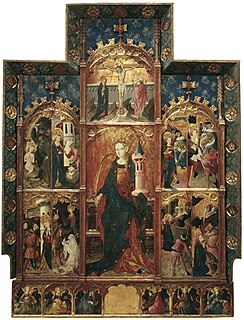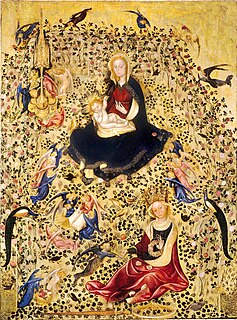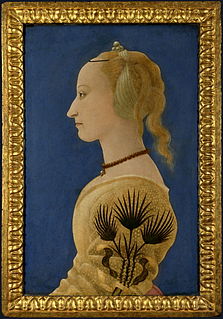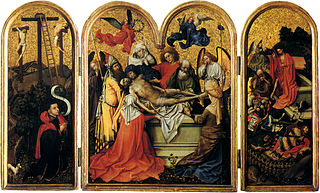 W
WA Man and A Woman is the title sometimes used for a pair of oil and egg tempera on oak panel paintings attributed to the Early Netherlandish painter Robert Campin, completed c. 1435. Although usually considered pendants or companion pieces, they may also have been wings of a since dismantled diptych. The latter theory is supported by the fact that the reverse of both panels are marbled, indicating that they were not intended to be hung against a wall.
 W
WThe Adoration of the Magi is a circa 1480-1485 oil on panel painting of the Adoration of the Magi by the Renaissance artist Geertgen tot Sint Jans in the collection of the Rijksmuseum.
 W
WAgony in the Garden is a 1405-1408 French painting in the international Gothic style, which has been in the Museo del Prado since May 2012. It was produced in Paris on a Baltic oak panel. The artist is unknown, though it could by Colart de Leon, who was painter and 'valet de chambre' to Louis I, Duke of Orléans, shown at bottom left and probably the commissioner of the work.
 W
WThe Altarpiece of Saint Barbara is a painting by Gonçal Peris conserved at the National Art Museum of Catalonia.
 W
WThe Altarpiece of the Saints John is a painting by Bernat Martorell conserved at the National Art Museum of Catalonia.
 W
WThe Archangel Raphael and Tobias with Two Saints is an undated oil on panel painting by Cima da Conegliano, now in the Gallerie dell'Accademia in Venice. To the left of the work is James the Great and to the right is Nicholas of Bari.
 W
WThe Christ as the Suffering Redeemer is a painting by the Italian Renaissance artist Andrea Mantegna, dated to c. 1488-1500 and housed in the Statens Museum for Kunst, Copenhagen, Denmark.
 W
WThe Crucifixion is a tempera painting by Andreas Pavias, who was active in Crete during the second half of the 15th century and is considered part of the Cretan School. It is now in the National Gallery of Greece.
 W
WDanse Macabre is a painting by Bernt Notke. A fragment of the late fifteenth-century painting, originally some 30 meters wide, is displayed in the St. Nicholas Church, Tallinn. It is regarded as the best-known and as one of the most valuable medieval artworks in Estonia. It is the only surviving medieval Dance Macabre in the world painted on canvas.
 W
WThe Dombild Altarpiece is a painted triptych by the German artist Stephan Lochner. Originally painted for the council-chapel St. Maria in Jerusalem in Cologne, it was moved to Cologne Cathedral in 1810 and is now in that church's Marienkapelle, south of the choir. It is also known as the Three Kings Altarpiece (Dreikönigsaltar) and the Patron Saints of Cologne Altarpiece.
 W
WEarly Netherlandish painting, traditionally known as the Flemish Primitives, refers to the work of artists active in the Burgundian and Habsburg Netherlands during the 15th- and 16th-century Northern Renaissance period. It flourished especially in the cities of Bruges, Ghent, Mechelen, Leuven, Tournai and Brussels, all in present-day Belgium. The period begins approximately with Robert Campin and Jan van Eyck in the 1420s and lasts at least until the death of Gerard David in 1523, although many scholars extend it to the start of the Dutch Revolt in 1566 or 1568. Early Netherlandish painting coincides with the Early and High Italian Renaissance but the early period is seen as an independent artistic evolution, separate from the Renaissance humanism that characterised developments in Italy, although beginning in the 1490s as increasing numbers of Netherlandish and other Northern painters traveled to Italy, Renaissance ideals and painting styles were incorporated into northern painting. As a result, Early Netherlandish painters are often categorised as belonging to both the Northern Renaissance and the Late or International Gothic.
 W
WThe Grey Passion is a series of paintings by Hans Holbein the Elder (1465-1524). Executed between 1494 and 1500, it comprises twelve panels illustrating the Passion of Christ; Holbein's monochrome palette is almost entirely grey. The paintings were purchased by the Staatsgalerie Stuttgart, the Stuttgart State Art Gallery in Germany. The State Art Gallery acquired the altarpiece in 2003 for 12 million euros. The restoration of the artworks lasted three years and cost 450 thousand euros.
 W
WHercules is a fresco fragment by Piero della Francesca, his only known secular work and probably originally part of a cycle of mythological figures. It dates to sometime after 1465 and is now in the Isabella Stewart Gardner Museum in Boston, which acquired it from Joseph Lindon Smith, who in turn bought it the Florentine art dealer Elia Volpi.
 W
WThe Holy Kinship is a circa 1495 oil on panel painting of Holy Kinship by the workshop of the renaissance artist Geertgen tot Sint Jans in the collection of the Rijksmuseum.
 W
WInternational Gothic is a period of Gothic art which began in Burgundy, France, and northern Italy in the late 14th and early 15th century. It then spread very widely across Western Europe, hence the name for the period, which was introduced by the French art historian Louis Courajod at the end of the 19th century.
 W
WJohn the Baptist in the Wilderness is an oil painting on oak panel executed c. 1480–1490 by the early Netherlandish painter Geertgen tot Sint Jans. It is now in the collection of the Gemäldegalerie, Berlin.
 W
WMadonna and Child is a c. 1400-1405 tempera and gold leaf on panel painting by Gentile da Fabriano, now in the Pinacoteca Nazionale di Ferrara. It is signed at the base. Before being restored in 1980 it was thought to be by a follower of the artist due to thick repainting on the whole work.
 W
WMadonna and Child is a tempera on panel painting of the enthroned Madonna and Child by Gentile da Fabriano. At its base are small angel musicians. It is now in the Galleria Nazionale dell'Umbria in Perugia.
 W
WThe painting of the Madonna of the Holy Trinity Church is the oldest surviving panel painting in České Budějovice and is one of the oldest known Gothic pictures with a painted frame. It is on display at the permanent collection of Aleš South Bohemian Gallery in Hluboká nad Vltavou.
 W
WThe Madonna of the Rose Garden is an International Gothic painting attributed to Michelino da Besozzo or Stefano da Verona. Dating to c. 1420–1435, it is now in the Castelvecchio Museum in Verona, northern Italy.
 W
WThe Madre della Consolazione (Crete) is an icon depicting the Virgin Mary holding baby Christ. It is believed to have originated during the mid-fifteenth century by Nikolaos Tzafouris.
 W
WThe Meister des Göttinger Barfüßeraltars was a Gothic German painter in Göttingen known for the creation of a large altarpiece in the Franciscan Church there in 1424. Although the church was demolished in around 1824, the altarpiece can be seen in the Lower Saxony State Museum in Hanover. The painting is 7.87 meters wide and 3.06 meters high, the largest preserved Gothic altarpiece in Lower Saxony (Niedersachsen). It was restored in 2005 after six years of work at a cost of 1.2 million euros.
 W
WTwo small paintings in London and New York are believed to come from the same predella, and are attributed to Zanobi Strozzi, a Florentine painter who was probably a pupil of Fra Angelico. They are an Adoration of the Magi in the National Gallery in London, and a Nativity in the Metropolitan Museum of Art in New York. They date to about 1433–34 and are in tempera and gold on panel.
 W
W130–136 Piccotts End is a medieval timber framed building in Piccotts End in Hertfordshire, England. Originally a hall house, the structure has been divided into a row of cottages. Two of the cottages are of interest for the art work they contain.
 W
WPietà of Villeneuve-lès-Avignon is an oil painting of the mid-15th century that is considered one of the outstanding works of art of the late Middle Ages. Following its appearance at an exhibition in 1904 its authorship was disputed, though it has since been accepted as the work of Enguerrand Quarton. It is now in the Musée du Louvre.
 W
WPortrait of a Lady in Yellow was painted by the Florentine artist Alesso Baldovinetti sometime in the second half of the 15th century, most likely c. 1465. For centuries the work was mis-attributed; it was purchased by the National Gallery London in 1866 as a portrait of Countess Palma of Urbino, attributed to Piero della Francesca. In 1911 art historian Roger Fry established that it was by Baldovinetti. However, there is no evidence of the source of the commission, and doubt remains as to the identity of the sitter; the most plausible theory is that she is Francesca degli Stati of Urbino.
 W
WThe Diptych of Philip de Croÿ with The Virgin and Child consists of a pair of small oil-on-oak panels painted c. 1460 by the Netherlandish artist Rogier van der Weyden. While the authorship and dating of both works are not in doubt, it is believed but not proven that they were created as wings of a devotional diptych and that at some unknown time the panels were broken apart. A diptych panel fitting the description of the Mary wing was described in a 1629 inventory of paintings owned by Alexandre d'Arenberg, a descendant of Philip I de Croÿ (1435–1511). Both have been approximately dated to 1460 and are now in Antwerp and San Marino, CA respectively. The reverse of de Croÿ's portrait is inscribed with the family crest and the title used by the sitter from 1454 to 1461.
 W
WSaint Francis of Assisi Receiving the Stigmata is the name given to two unsigned paintings completed around 1428–1432 that art historians usually attribute to the Flemish artist Jan van Eyck. The panels are nearly identical, apart from a considerable difference in size. Both are small paintings: the larger measures 29.3 cm x 33.4 cm and is in the Sabauda Gallery in Turin, Italy; the smaller panel is 12.7 cm x 14.6 cm and in the Philadelphia Museum of Art. The earliest documentary evidence is in the 1470 inventory of Anselm Adornes of Bruges's will; he may have owned both panels.
 W
WSaint George and the Princess is a late 15th century tempera on panel painting, attributed to Antonio Cicognara and now in the Pinacoteca Tosio Martinengo in Brescia.
 W
WThe Seilern Triptych, variously dated c. 1410-15 or c 1420-25 is a large oil and gold leaf on panel, fixed winged triptych altarpiece generally attributed to the Early Netherlandish painter Robert Campin. It is the earliest of two known triptychs attributed to him., although the outer wing panels paintings are lost. The work details the events of Christ's passion; with iconography associated with the liturgy of Holy Week. The panels, which should be read from left to right, detail three stations of the cycle of the Passion of Jesus; the crucifixion, the burial and the resurrection.
 W
WThe Trinity Altarpiece, also known as the Trinity Altar Panels, is a set of four paintings in oil on wood thought to have been commissioned for the Trinity College Kirk in Edinburgh, Scotland, in the late fifteenth century.
 W
WThe Vienna Diptych or the Fall and Redemption of Man is a religious diptych by the Flemish artist Hugo van der Goes depicting the fall of man on the left panel and the lamentation of Christ on the right panel. Painted in the second half of the 15th century, the diptych is housed in the Austrian Kunsthistorisches Museum, Vienna.
 W
WThe Virgin and Child with Four Holy Virgins is a 15th-century oil on panel painting by the Dutch artist Master of the Virgo inter Virgines in the collection of the Rijksmuseum.
 W
WVirgin with the Standing Child, Embracing his Mother, also known as Willys Madonna is a painting by the Italian Renaissance master Giovanni Bellini. It is now in the São Paulo Museum of Art in São Paulo, Brazil.